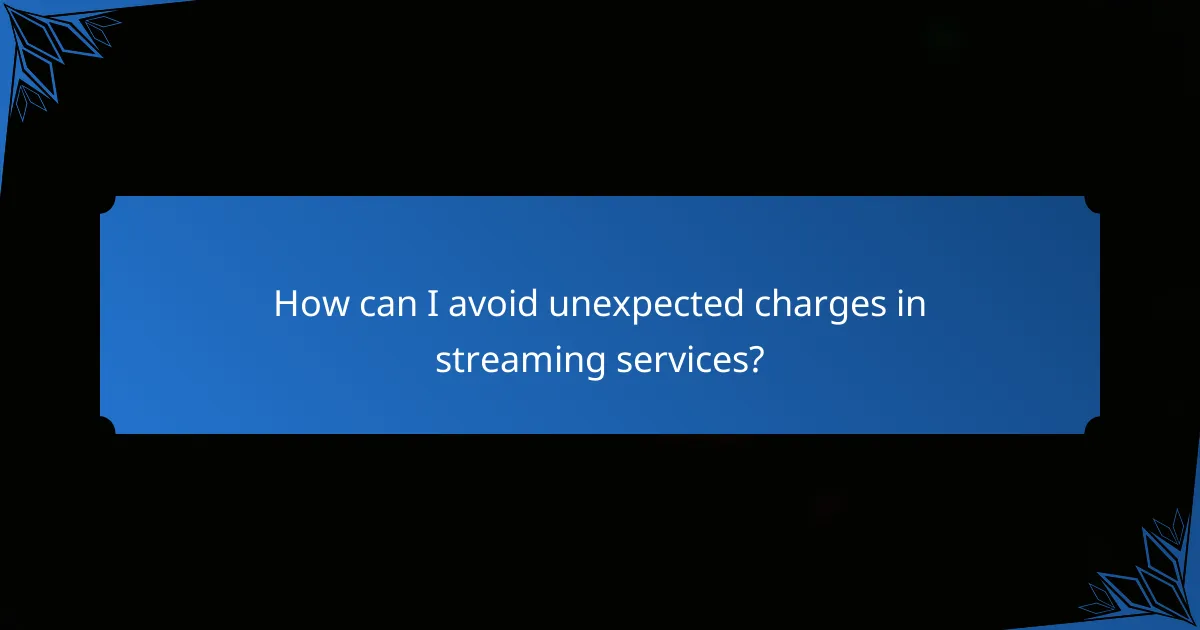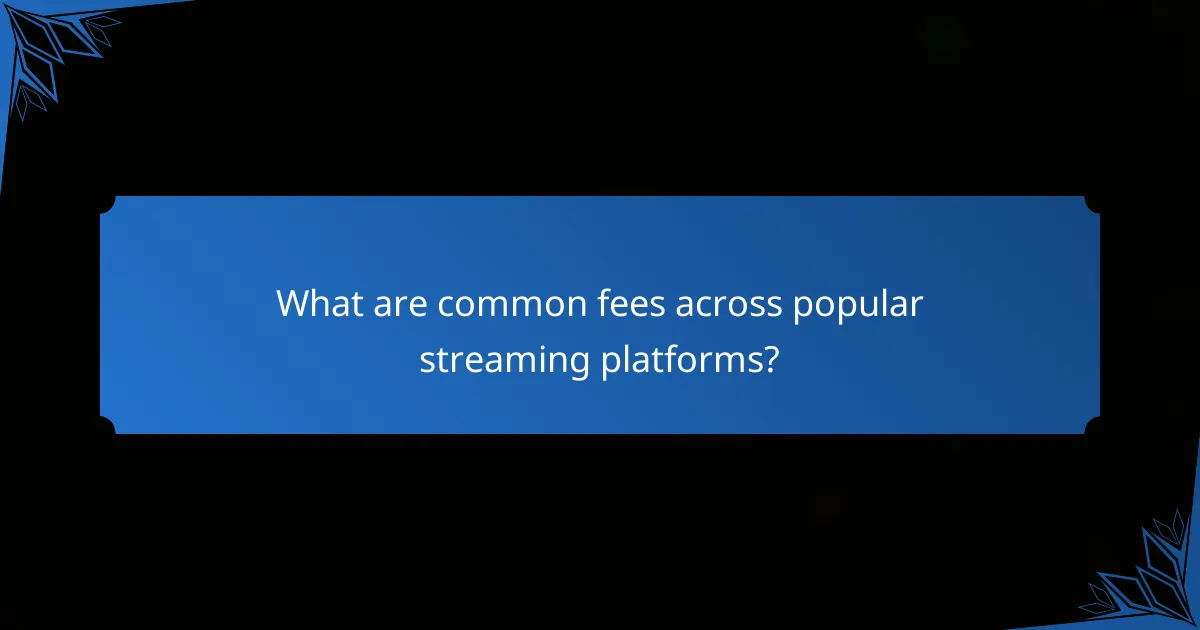As streaming services continue to gain popularity, many users are unaware of the hidden costs that can inflate their monthly expenses. These additional charges may stem from device compatibility fees, promotional rate expirations, and various add-ons that can catch subscribers off guard. By staying informed about these potential pitfalls and regularly reviewing billing statements, consumers can better manage their streaming budgets and avoid unexpected financial surprises.

What hidden costs should I expect in streaming subscriptions?
Hidden costs in streaming subscriptions can significantly increase your overall expenses. These costs may include monthly fees, activation charges, device compatibility fees, regional pricing variations, and promotional rate expirations.
Monthly fees
Monthly fees are the most apparent cost associated with streaming subscriptions. However, many services may have tiered pricing, where higher tiers offer additional features or content. Always check if the basic plan meets your needs or if you will need to upgrade for desired content.
Some platforms may also charge extra for access to premium content or ad-free experiences, which can add to your monthly expenses. Comparing different services can help identify the best value for your viewing habits.
Activation charges
Activation charges are often overlooked but can be a part of the initial setup for some streaming services. These fees may apply when you first sign up or if you switch plans. It’s essential to read the fine print when subscribing to understand any upfront costs.
Some services may waive activation fees during promotional periods, so timing your subscription can save you money. Always inquire about these charges before committing to a service.
Device compatibility fees
Device compatibility fees can arise if you need to purchase specific hardware to access certain streaming services. Some platforms may charge extra for using their proprietary devices or apps, which can add to your overall costs.
Before subscribing, check if your existing devices support the streaming service. If not, factor in the cost of new devices, which can range from low tens to hundreds of dollars, depending on the technology required.
Regional pricing variations
Regional pricing variations can lead to different subscription costs based on your location. Streaming services often adjust their pricing according to local market conditions, which can result in significant differences between countries.
For example, a subscription that costs $10 in the U.S. may be priced at €8 in Europe or BGN 20 in Bulgaria. Always verify the local pricing before subscribing to avoid unexpected charges.
Promotional rate expirations
Promotional rates can provide an attractive initial price for streaming subscriptions, but these rates often expire after a set period. Once the promotional period ends, your subscription may automatically renew at a higher standard rate.
To avoid surprises, keep track of when your promotional rate expires and what the new rate will be. Consider setting reminders to reassess your subscription options before the renewal date to ensure you’re still getting the best deal.

How can I avoid unexpected charges in streaming services?
To avoid unexpected charges in streaming services, carefully review subscription details and monitor your billing regularly. Understanding fees, promotional periods, and cancellation policies can help you stay within your budget.
Read the fine print
Reading the fine print is crucial when signing up for streaming services. Terms and conditions often include details about additional fees, such as those for premium content or device rentals. Look for clauses regarding automatic renewals and price increases after promotional periods.
Many services offer free trials that convert into paid subscriptions unless canceled. Be aware of the duration of these trials and any obligations that come with them to avoid unwanted charges.
Track billing cycles
Keeping track of your billing cycles helps you anticipate charges and manage your budget effectively. Most streaming services bill monthly, but some may have different schedules or offer annual subscriptions that can lead to larger one-time charges.
Set reminders for when your billing cycle starts and ends. This way, you can review your usage and decide whether to continue or cancel subscriptions before the next charge hits your account.
Use budgeting tools
Utilizing budgeting tools can help you manage your streaming expenses more effectively. Many apps allow you to track subscriptions and set spending limits, ensuring you stay within your financial goals.
Consider creating a dedicated category in your budget for entertainment subscriptions. This can help you visualize how much you spend on streaming services and identify areas where you can cut back if necessary.

What are common fees across popular streaming platforms?
Common fees in streaming subscriptions can include additional device charges, add-on subscriptions, and rental fees for specific content. Understanding these costs helps consumers make informed decisions about their streaming services.
Netflix additional device fees
Netflix typically charges extra for additional devices beyond the standard plan limits. For instance, the basic plan allows streaming on one device, while the standard plan supports two devices, and the premium plan accommodates four. If you exceed these limits, you may need to upgrade your plan, which can increase your monthly bill by several dollars.
Consider your viewing habits before selecting a plan. If multiple users in your household watch simultaneously, opting for a higher-tier plan may save you from unexpected charges.
Hulu add-on subscription costs
Hulu offers various add-on subscriptions that can enhance your viewing experience but also increase your overall costs. Options include premium channels like HBO Max or Showtime, and features such as ad-free viewing. Each add-on typically costs between $5 to $15 per month, depending on the service.
Evaluate which add-ons are essential for your viewing preferences. Bundling services can sometimes provide savings compared to subscribing to each separately.
Amazon Prime video rental fees
While Amazon Prime Video is included with an Amazon Prime membership, many titles are available for rent at additional costs. Rental fees can vary widely, often ranging from $2 to $6 per title, depending on the movie’s release date and popularity. New releases typically cost more than older films.
Be mindful of rental periods, as most titles are available for a limited time. Once you start watching, you usually have 48 hours to finish the film. Planning your rentals can help avoid unnecessary charges.

How do regional differences affect streaming subscription costs?
Regional differences significantly influence streaming subscription costs, affecting both pricing and content availability. Factors such as local currency, market competition, and regulatory environments can create variations in what consumers pay and what they can access.
Pricing variations by country
Streaming services often adjust their pricing based on the economic conditions of each country. For instance, a subscription that costs around $10 in the United States may be priced lower in countries with lower average incomes, such as $5 in some Southeast Asian nations. This pricing strategy helps companies remain competitive and accessible in diverse markets.
Additionally, promotional offers and discounts can vary widely. Some regions might see introductory rates or bundled deals that are not available elsewhere, making it essential for consumers to compare options based on their location.
Content availability differences
Content availability can differ dramatically between regions due to licensing agreements and local regulations. For example, a popular series available on a U.S. streaming platform may not be accessible in Europe or Asia. This discrepancy can lead to frustration for users who expect the same offerings globally.
To navigate these differences, users should research what content is available in their region before subscribing. Some services allow users to access content from other regions through VPNs, but this may violate terms of service and lead to account suspension.
Tax implications on subscriptions
Taxes can also impact the final cost of streaming subscriptions. In many countries, value-added tax (VAT) or sales tax is applied to digital services, which can increase the overall price by a significant percentage. For instance, in the European Union, VAT rates can range from 17% to 27%, adding to the base subscription cost.
Consumers should factor in these potential taxes when budgeting for streaming services. It’s advisable to check local laws regarding digital services to understand how much tax will be added to the subscription price.

What are the long-term financial impacts of streaming subscriptions?
The long-term financial impacts of streaming subscriptions can accumulate significantly, often exceeding initial expectations. While monthly fees may seem manageable, additional costs such as hidden charges, device compatibility, and content purchases can lead to higher overall expenses over time.
Annual cost comparisons
When comparing annual costs of streaming subscriptions, it’s essential to consider both the base subscription fees and any extra costs that may arise. For example, while a single streaming service might charge around $10 to $15 per month, additional fees for premium content or add-ons can push the annual total to $200 or more.
To make informed decisions, evaluate the total yearly cost of multiple subscriptions versus traditional cable packages. Many consumers find that bundling services can offer savings, but it’s crucial to read the fine print to avoid unexpected fees.
Bundling options with internet services
Bundling streaming subscriptions with internet services can provide financial benefits, often resulting in lower overall costs. Many internet providers offer packages that include popular streaming services, which can save consumers money compared to subscribing separately.
However, it’s important to assess the terms of these bundles. Some may require long-term contracts or limit access to certain content. Always compare the bundled price against individual subscription costs to ensure you’re getting the best deal.



